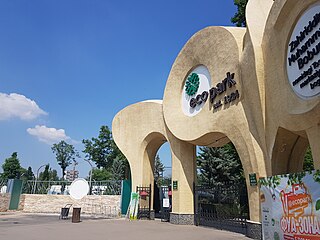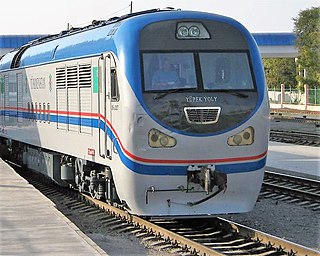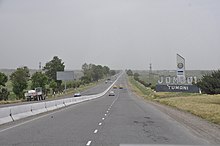
The Amu Darya, also called the Amu, the Amo, and historically the Oxus, is a major river in Central Asia and Afghanistan. Rising in the Pamir Mountains, north of the Hindu Kush, the Amu Darya is formed by the confluence of the Vakhsh and Panj rivers, in the Tigrovaya Balka Nature Reserve on the border between Afghanistan and Tajikistan, and flows from there north-westwards into the southern remnants of the Aral Sea. In its upper course, the river forms part of Afghanistan's northern border with Tajikistan, Uzbekistan, and Turkmenistan. In ancient history, the river was regarded as the boundary of Greater Iran with Turan, which roughly corresponded to present-day Central Asia. The Amu Darya has a flow of about 70 cubic kilometres per year on average.
Transport in Turkmenistan includes roadways, railways, airways, seaways, and waterways, as well as oil-, gas-, and water pipelines. Road-, rail-, and waterway transport fall under the jurisdiction of the Ministry of Industry and Communications.

Transport in Afghanistan is done mostly by road, rail and air. Much of the nation's road network was built in the mid-20th century but left to ruin during the last two decades of that century due to war and political turmoil. Officials of the current Islamic Emirate have continued to improve the national highways, roads, and bridges. In 2008, there were about 700,000 vehicles registered in Kabul. At least 1,314 traffic collisions were reported in 2022.

The Uzbek Soviet Socialist Republic, also known as Soviet Uzbekistan, the Uzbek SSR, UzSSR, or simply Uzbekistan and rarely Uzbekia, was a union republic of the Soviet Union. It was governed by the Uzbek branch of the Soviet Communist Party, the legal political party, from 1925 until 1990. From 1990 to 1991, it was a sovereign part of the Soviet Union with its own legislation.

The Asian Highway Network (AH), also known as the Great Asian Highway, is a cooperative project among countries in Asia and the United Nations Economic and Social Commission for Asia and the Pacific (ESCAP) to improve their connectivity via highway systems. It is one of the three pillars of the Asian Land Transport Infrastructure Development (ALTID) project, endorsed by the ESCAP commission at its 48th session in 1992, comprising Asian Highway, Trans-Asian Railway (TAR) and facilitation of land transport projects.

Türkmenabat, formerly Amul, Çärjew, and Novy Chardzhuy, is the second-largest city in Turkmenistan and the administrative centre of Lebap Province. As of 2009, it had a population of approximately 254,000 people. From 1924 to 1927, it was also named Leninsk in honor of Vladimir Lenin.

This article discusses the administrative-territorial division of the Republic of Uzbekistan. The Article 68 of the constitution of Uzbekistan defines:
The Republic of Uzbekistan shall consist of regions, districts, cities, towns, settlements, kishlaks and auls (villages) in Uzbekistan and the Republic of Karakalpakstan.

Termez is the capital of Surxondaryo Region in southern Uzbekistan. Administratively, it is a district-level city. Its population is 182,800 (2021). It is notable as the site of Alexander the Great's city Alexandria on the Oxus, as a center of early Buddhism, as a site of Muslim pilgrimage, and as a base of Soviet Union military operations in Afghanistan, accessible via the nearby Hairatan border crossing.

The Trans-Caspian Railway is a railway that follows the path of the Silk Road through much of western Central Asia. It was built by the Russian Empire during its expansion into Central Asia in the 19th century. The railway was started in 1879, following the Russian victory over Khokand. Originally it served a military purpose of facilitating the Imperial Russian Army in actions against the local resistance to their rule. However, when Lord Curzon visited the railway, he remarked that he considered its significance went beyond local military control and threatened British interests in Asia.

Tourist activities in Uzbekistan range from outdoor activities, such as rock-climbing, to exploration of its archeological and religious history. The Statistical Internet Survey conducted between May 7 and August 27, 2008, found that the majority of those surveyed (39%) visit Uzbekistan due interest in its architectural and historical sites. The next-largest group (24%) visited Uzbekistan to observe its culture, way of life, and customs.

The Central Asia – Center gas pipeline system is a Gazprom controlled system of natural gas pipelines, which run from Turkmenistan via Uzbekistan and Kazakhstan to Russia. The eastern branch includes the Central Asia – Center (CAC) 1, 2, 4 and 5 pipelines, which start from the south-eastern gas fields of Turkmenistan. The western branch consists of the CAC-3 pipeline and a project to build a new parallel Caspian pipeline. The western branch runs from the Caspian Sea coast of Turkmenistan to north. The branches meet in western Kazakhstan. From there the pipelines run to north where they are connected to the Russian natural gas pipeline system.

As of March 2017, the total length of Uzbekistan's main railway network is 4,714 kilometres (2,929 mi). A large percentage of the system's track requires major repair. The main line is the portion of the Transcaspian Railroad that connects Tashkent with the Amu Darya. There are rail links with Kazakhstan, Kyrgyzstan, Tajikistan, Afghanistan, and Turkmenistan. Suburban traffic only exists around Tashkent.

The Syr-Darya Oblast was one of the oblasts of the Russian Empire, a part of Russian Turkestan. Its center was Tashkent.

Asian Highway 5 (AH5) is an east-west route of the Asian Highway Network, running 10,380 km (6,450 miles) from Shanghai, China via Kazakhstan, Kyrgyzstan, Uzbekistan, Turkmenistan, Azerbaijan, Georgia to the border between Turkey and Bulgaria west of Istanbul where it connects to AH1 and E80.

Much of the influence of the Soviet Union can be seen in the infrastructure of Central Asia. Central Asia is a nexus of said infrastructure for transportation, goods delivery and energy distribution. Much of the industrial infrastructure had greatly declined in the 1990s, after the fall of the Soviet Union, especially in Kyrgyzstan and Tajikistan. The roads, railroads and energy lines are thus oriented towards the Russian Federation and away from other regional neighbors, such as China, Afghanistan or Iran.

Turkmenistan has 4,980 kilometres (3,090 mi) of railways. The railway operator is the state owned company Türkmendemirýollary. The company belongs to the Ministry of Railways of Turkmenistan. Turkmenistan is currently expanding its rail system to cover 5,256.25 kilometres (3,266.08 mi) more distance, which will take its network to 10,236.25 kilometres (6,360.51 mi) track kilometres by 2025.

The Railways Agency of Turkmenistan (Turkmen: "Türkmendemirýollary" agentligi, previously the Ministry of Railways, is a government agency in Turkmenistan responsible for oversight of the state rail corporation "Demirýollary" AGPJ.

High speed rail in Uzbekistan currently consists of 600 km of track and services using Talgo 250 equipment, branded Afrosiyob by operator Uzbekistan Railways, on upgraded conventional lines. All HSR lines have been built using upgraded lines on Russian gauge. Other regional railways exist.

The Afghanistan–Uzbekistan border is 144 km (89 mi) in length and runs from the tripoint with Turkmenistan to the tripoint with Tajikistan along the Amu River. It is the shortest of Uzbekistan's external borders. The city of Termez in Uzbekistan and the town of Hairatan in Afghanistan are the closest major populated centers to the border.

Asian Highway 62 (AH62) is an international route running 2,105 kilometres (1,308 mi) from Petropavlovsk in Kazakhstan to Mazar-i-Sharif in Afghanistan. This international highway transits Uzbekistan also.



















